The Pentax Program Plus (in North America) or Program A to the rest of the world, an automatic exposure manual-focus 35mm SLR film camera, was introduced by Pentax in 1984 as part of a new range of Pentax 'A Series' cameras. The model is a lesser sibling of the fully-featured Super Program (Super A) model with some functions removed.
The 'A Series' cameras update the manual focus 'M Series' (ME F, ME, ME Super, MG, MV, MV1, and MX) which were in production previously from 1981-85 with a fully programmed exposure control system that can adjust both aperture and shutter speed automatically, a new 'KA-mount' system, an updated form factor that incorporates a finger grip, and a lighter and more refined body design.
Models in the series include the Pentax Super Program (Super A) (1983–1987), Program Plus (Program A) (1984–1988), and A3000 (A3) (1985–1987). The series also saw the introduction of the SMC Pentax-A series lenses, which are required for the KA-mount cameras to properly implement the programmed exposure control system. For backward compatibility, the KA-mount allows existing K- and KM-mount lenses to be used in manual and aperture-priority modes on the new cameras.
Pentax Program A (Program Plus) - out and about in Oxfordshire in 3 minutes
The Pentax Program A (Program Plus in North America) is a beautifully designed 35mm SLR. It has the same functionality as the Minolta X700 and Canon AE1 Prog...
Another first for the 'A-series' cameras was the use of LCD digital displays for exposure information. The pair of panels were aligned on the lower part of the viewfinder screen, and to save battery power, the panels were back-illuminated by a translucent light panel located on the front part of the pentaprism top. Both the Pentax Super Program (Super A) and Program Plus (Program A) were fitted with this feature.
Basic Camera Features
Mechanically, the Program Plus (Program A) comes fitted with a Seiko MFC-E5 metal vertical run focal plane shutter with an electronically controlled speed range from 15 to 1/1000 second, a mechanical setting of 1/100 second for flash sync., and B. Metering range is from EV 1 (F1.4, 1 sec.) to EV 18 (F16, 1/1000 sec. or F22, 1/500 sec.) with 50mm F1.4 lens and ISO 100 film.Film ISO speed range is 6-3200, Exposure Compensation at 4X, 2X, 1X, 1/2X, and 1/4X. The camera is also fitted with a DoF (Depth of Field) preview lever, and an electronically controlled 12-second delay self-timer activated by the shutter release button.
A simple and uncluttered front populated by the sculptured finger grip and the raised lens mount housing that continues up to the pentaprism head as the main features, with a cluster of features including the lens release button, DoF preview lever, and the self-timer switch located within the space between the finger grip and the vertical of the lens mount housing.
The top panel, where most of the functional controls of the camera are located, is populated first by the integrated rewind crank, pull-up film back latch release, pull-up and turn film ISO speed indicator, and exposure compensation dial located on the left of the top plane. Next is the pentaprism, hot shoe, and viewfinder eyepiece hump, and on the right of the top plane, the cluster of shutter speed selector push-buttons, shutter speed, shutter lock dial, shutter release button, film forward crank, and film counter window.
A plain back, with just the viewfinder eyepiece on the back of the camera's top panel, with the hinged film back with the finger-grip-memo-holder fitment occupying the rest of the film back.
On the bottom plane, from left to right, are the motor drive coupling gear, motor drive alignment contact, rewind release button, tripod socket, battery chamber cover, and motor drive electrical contacts.
The film box is a standard configuration as seen on most SLR film cameras of that era with the film canister chamber on the left end of the body, followed by the shutter window, sprocket gear, and multi-pin take-up spool on the opposite end of the film box.
Film Loading and Rewind
Film loading on the Pentax Program Plus is the standard manual procedure of opening the film back, placing the film canister into the canister chamber, pulling the film tab across the film box and inserting the film tab end into one of the magic needle slots, and tensioned towards the inner side of the take-up spool. The film is wound emulsion side up.Once the film back is closed, do the two blank shots sequence to bring the unexposed part of the film properly to Frame 1 before commencing with exposed shots for the rest of the film roll.
To rewind, press the film rewind release button located on the bottom plane of the camera, and turn the film rewind crank in the clockwise direction until the film is completely rewound before taking the film canister out and sending it for processing.
Viewfinder Readout
In Programmed AE mode, the shutter speed and lens aperture setting are displayed on the pair of LCD displays aligned below the image field.
The LCD display will vary according to the exposure mode the camera was set to, and other information such as 'over' and 'underexposure warning and values, low battery indicator, and erroneous operations which will, in tandem, disable shutter release.
Exposure Modes
The Pentax Program Plus provides an array of four exposure modes for the ease of your photography:- Programmed AE - Applicable only with the use of SMC Pentax-A lenses. Set the Shutter Speed Dial to 'Auto' and the lens aperture setting to 'A'.
- Aperture-priority AE - Applicable with K, KF, or KA series lenses. Set Shutter Dail to 'Auto' and the lens aperture to the desired value you want to shoot with. The camera will set the shutter speed automatically.
- Metered Manual - You are free to adjust both the lens aperture opening and the shutter speed of the camera. In this mode, you might also want to consider Exposure Compensation as part of your creative content.
- Programmed Auto Flash - Set lens aperture set to 'Auto' with KA lenses, or to a value for normal auto flash with any other lens. Set the Shutter Speed dial set to 'Auto' for dedicated flash units, or '100' for other types.
Batteries and Camera Body Weight
The Pentax Program Plus requires the use of a pair of LR/SR44 button cells to power its electronics. A low battery warning is indicated by an alternate display exposure setting and '000'. The camera will not power up when the batteries are depleted.The Pentax Program Plus camera's body weight is 490 grams without batteries.
Instruction Manual
The instruction manual for the Pentax Program Plus is available from buktus.org (donations accepted) and you may download the instruction manual from this link here.In Use
As a user-grade camera, the Pentax Program Plus / Program A is a slightly lesser sibling of the more advanced Super Program / Program A and comes with a top shutter speed of 1/1000 sec. as compared to the top shutter speed of 1/2000 sec. as available on the Super Program, no Shutter-priority AE mode, and no LCD illuminator light.Other than that it is still a very competent SLR film camera, which sets itself apart as one with a fully Programmed AE mode, Depth of Field preview, LED display exposure setting, and cross-compatibility with later and newer Pentax cameras.
In use, the camera fits nicely and snugly in your hands, all finger controls are within easy reach, and with a body weight that is light enough for the camera to be used almost single-handed. The opportunity to test your creativity, and beyond, is all but apparent here. Highly recommended, the one to go for!



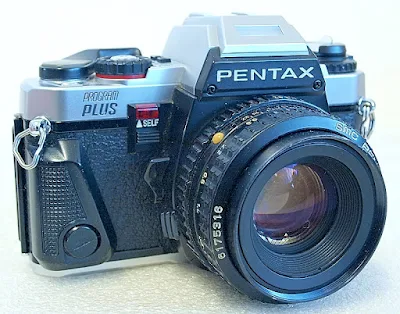

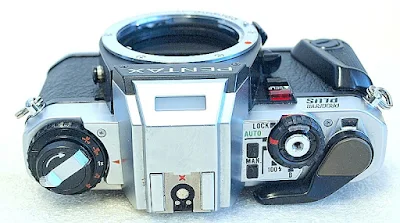

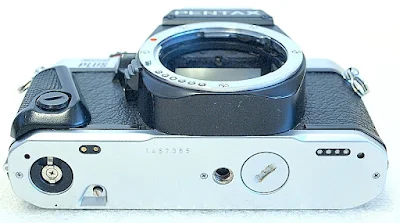

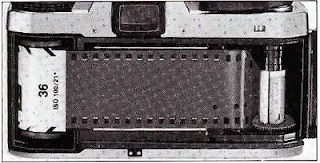
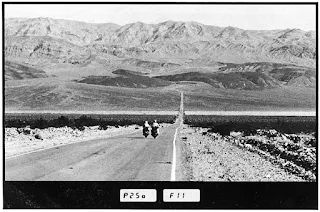












Hi there! I just got myself a Pentax Program Plus. For a while now, I had been wanting to learn to shoot on film. Since I'm new to this I am afraid I might have gotten scammed. I bought new batteries and don't see anything on the viewfinder. On the bottom left a 1000 number shows up but nothing on the right. I was given some old film for it, so I don't know if that has anything to do with it. Also, the lens that came with it is not Pentax original, it's a different brand. Feeling very lost and could use a lot of help!
ReplyDeleteAny tips? I would so appreciate guidance!
Hi,
DeleteFirst, if the lens is 'SMC Pentax-A' compatible, look at the aperture ring for a button which you can press and turn the aperture lens to its 'A' setting located after the numeral '22'. This will set the lens to 'Auto' mode and enables the bottom right LCD display in the viewfinder.
If the lens is only 'SMC Pentax' or 'SMC Pentax-M' compatible, then you will not find this button and you can only use the lens in manual mode - set the aperture setting you want to shoot with and the bottom left LCD in the viewfinder will display the shutter setting selected.
Next, best thing to do is go down to buktus.org and download the Pentax Super Program manual ( https://www.cameramanuals.org/pentax_pdf/pentax_super_program.pdf ). Go through the manual fully and see how more you will understand on how to use the camera ....
All the best, thanks.
Thank you for this post and review. Just got one of these as my first film camera. My one question is on the batteries. I understand they are required to be able to control the shutter speed. Are they required in general? Also I can't seem to find the SR44 only LR44. Will they work the same?
ReplyDeleteYou need the batteries to power the metering and shutter system of the camera, without which the camera will not operate.
DeleteLR44 and SR44 are the same physical size. While the LR44 battery is alkaline while the SR44 is silver oxide. The SR44 has a flat voltage discharge profile, meaning that the power output remain about the same until they are flat. The LR44 has a sloping discharge profile and as you use them up over time, their power output reduces until they are eventually flat.
The SR44 are a bit more pricey and are a bit more difficult to get. Thank you.
Thanks for the reply. When I took the camera in to my local camera shop to have them check it out the sold me some Energizer A76.
DeleteOverall this camera is a joy to use. Thank you again for this review of it.
Most welcome...
DeleteHello again. Do you happen to know what shutter release cable would be compatible with this camera? I can't seem to find anything specific online.
DeleteJust any threaded shutter cable release for 35mm film cameras will do, it is a standard item. The threaded end screws on to the socket in the middle of the shutter release button, thanks - https://www.google.com/search?q=shutter+release+cable
DeleteThanks again. Did not realize it was so universal.
DeleteHi - Thanks so much for this review! I received this camera (new to film) and had a question about the viewfinder LCD display. Should the readout be illuminated with an orange-ish backlight? I replaced the batteries but still have difficulty when it's dark reading the display, although verrrry occasionally I have noticed the readout lit orange which makes it easier to read. Should that be the norm or am I envisioning things?
ReplyDeleteAs far as I know, the Program Plus does not have any facilities for backlighting the LCD display window which is illuminated by natural external light via the window on the front top of the pentaprism hump. Depending on the external light sources, what you see is what you get, thanks.
DeleteAhh that explains it, much appreciated!
DeleteHello, my girlfriend has this camera and she ran out of film. What type of film does it use? Is Fujifilm Fujicolor C200 ok for it or do you have any other recomandations? Thanks!
ReplyDeleteYes, Fujifilm Fujicolor C200 is ok, so are any other black-and-white of color negative films, black-and-white or color slide films, infrared film... as long as they come in the standard 12, 24, or 36 frames 35mm film rolls, and are ASA rated to suit the camera, thanks, see https://www.learnfilm.photography/can-you-put-any-film-in-any-film-camera/
DeleteThanks for all the help, YOU ROCK! Have a great weekend!
DeleteThank you, most welcome!
DeleteI bought one shortly after it's release with a kit lens. I still have both
ReplyDeleteHello there! I got this camera recently and have been shooting on it for a couple months. I got two rolls developed and they came out blank. I then finished two more, where one of them turned out awesome but the other one was blank. I’m loading the film right and can advance the film with ease after each shot, but I haven’t been having much luck with my rolls. Do you know or recommend anything if my rolls keep turning out blank? Something specific about the camera I should know about? Is this a more common occurrence with the program plus?
ReplyDeleteThanks!
Duplicate what you did with the film back open, with no film, and see if the shutter curtain misses firing each time you release it...
DeleteMy best best is that you did not load the film properly and it does not forward..., learn to how to watch for this, and the pin roller catch of the take up spool needs getting famaliar with....
Thanks